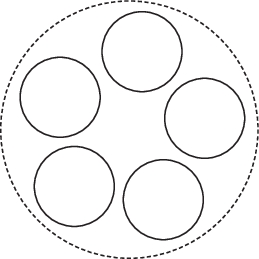Scale
The size, or scale, of an object has a crucial influence on its nature.
The significance is as decisive as geometry itself. Consider: the two circles are identical except that one is larger than the other. Are there any differences between them other than that simple difference in size?

Yes. Their proportions differ in a fundamental way: relative to their respective areas, the circumference (edge) of the large circle is less than that of the small one. The larger a circle, the smaller its edge relative to its area; the area rises with the square of the radius, whereas the circumference rises in simple proportion to the radius. And in the case of a three dimensional object, such as a sphere, the volume rises with the cube of the radius, where the surface area rises only with its square. Large shapes (and systems) have a low edge ratio, small ones have a high edge ratio.S1
This rule of geometry can have some advantages for large organisms: for instance, having a small surface area (relative to its size) helps a large animal to conserve heat, enabling it to have the slower metabolic rate associated with long life. And there are other advantages such as improved powers to defend itself (but it may also be a more tempting target), the ability to forage over a large area (but it needs more food), a body capable of supporting a heavy brain, and (in the case of the human animal) being large enough to manage fire. And for human societies too there are advantages of scale—a bigger pool of talent and better orchestras, for instance—so scale is not a matter of small-is-always-best; it is a matter of being the right size. But there are good reasons for a strong presumption—a reliable default position—in favour of small.
The advantages that large scale does enjoy come at a high cost. The key to this is that a large system has a relatively short boundary (border, edge, surface) across which it can obtain its needs. Large animals and societies have to go to a lot of trouble to import sufficient nutrients and energy which then have to be distributed over larger distances in their bodies, with waste having to travel all the way back to the boundary. And in a large human community, material waste comes up against the sorting problem and tends to be lost from the system rather than recycled.
On the large scale (say, a modern city), decision-making is affected too—people lose the sense that matters affecting them are their responsibility or within their power. Meanwhile, top-down governance is so far removed from the local detail that the only option open to those responsible is to develop some form of ideology.
The fundamental problem with large scale is that with each advance in size there is a necessary increase in complication. Large animals—whose ratio between volume and surface-area means that the absorption of food and oxygen is a problem—have to make up for this with diverse and ingenious devices such as lungs, and the velvety textures which confer an enormous surface area on their guts. As the biologist J.B.S. Haldane writes in his classic essay, “On Being the Right Size”,
Comparative anatomy is largely the story of the struggle to increase surface in proportion to volume. . . . The higher animals are not larger than the lower because they are more complicated. They are more complicated because they are larger.S2
Applying this to settlements and economies, the inevitable complications of largeness lead to three things:
1. a loss of elegance, as large infrastructures (the intermediate economy) have to be maintained in order to enable the simple act of living;
2. a loss of judgment, as inflexible, standardised, rationalist solutions and ideologies destroy the local detail—that living part of the urban ecology on which the rest depends; and
3. a loss of presence, as people surrender the power to build the institutions they want, which would enable lives that make sense to them. The system as a whole sacrifices the intelligence it needs: it loses its minds.

The relevant response to large scale is to transform the system’s structure: subdivide one big thing into many smaller ones; make it modular. For example, in the diagram to the left, one of the circular systems we met at the start of this entry has, at the cost of some loss of area, increased its total edge many times over. In the second diagram below, the same principle is applied again, taking the modular construction down to the local level, and building a nested hierarchy of holons, or local communities—small enough to recognise themselves as communities, close enough to form clusters of cooperation, while still having a generous edge across which to import their material needs and export their wastes in a small enough scale to allow for recycling.S3
 Here we have the rescaling of society. It is the essence of what the Transition movement is trying to do. But then, of course, comes the snag: they need hinterland. Modularity does not provide solutions on its own; it needs a setting in the form of an ecology which can supply materials and energy, and recycle its waste. Without that ecological setting the small-scale holonic structure loses half of its point. Having access to a nearby edge across which to import materials and export waste is no advantage if, pressing up against that edge, there is another, virtually identical, holon, needing to do the same thing. But that does not make modularity any less critical: it is a necessary condition. In any case, some communities do have access to the hinterland they need. And other communities will discover, and be surprised by, solutions which they would not have discovered if they had not developed a modular structure in the first place, against the odds.S4
Here we have the rescaling of society. It is the essence of what the Transition movement is trying to do. But then, of course, comes the snag: they need hinterland. Modularity does not provide solutions on its own; it needs a setting in the form of an ecology which can supply materials and energy, and recycle its waste. Without that ecological setting the small-scale holonic structure loses half of its point. Having access to a nearby edge across which to import materials and export waste is no advantage if, pressing up against that edge, there is another, virtually identical, holon, needing to do the same thing. But that does not make modularity any less critical: it is a necessary condition. In any case, some communities do have access to the hinterland they need. And other communities will discover, and be surprised by, solutions which they would not have discovered if they had not developed a modular structure in the first place, against the odds.S4
And here we have the testimony of a reformer who used small scale to good effect. Thomas Chalmers (1780–1847) was the vicar of the parish of St. John in Glasgow, and invented the system of poor relief which established and maintained personal contact with poor families. It was based on fully-developed mentoring relationships between applicant and provider. Chalmers and his colleagues in the scheme talked through the options with each applicant; in the absence of alternatives, financial relief was provided, but personal contact was the key. Its success in reducing poverty, in building morale, and in opening up the possibility of financial recovery, was recognised; the money saved was used to endow schools in the area, and the method was widely copied. The key to the scheme—intelligent personal engagement between the providers and the people in need—made it necessary to keep each area of administration small enough for that personal contact to be sustained.S5
Such an approach works only on a small scale: a national scheme would need to be subdivided into local programmes. As Chalmers noted,
There is a charm in locality most powerfully felt by every man who tries it . . . who has personally attached himself to a manageable portion of the civic territory. The very visibility of the limit, by constantly leading him to perceive the length and breadth of his task, holds out an inducement to his energies, which, however difficult to explain, will be powerfully felt and proceeded on. There is a very great difference, in respect of its practical influence, between a task that is indefinite, and a task that is clearly seen to be overtakeable. The one has the effect to paralyse; the other to quicken exertion.S6
Small scale declutters. There is elegance. The work it does produces the results it wants. It is not consumed and distracted with sustaining the large-scale infrastructures and abstractions it is lumbered with. There is eye contact.
Related entries:
Introduction, Groups and Group Sizes, System Scale Rule, Social City.
« Back to List of Entries